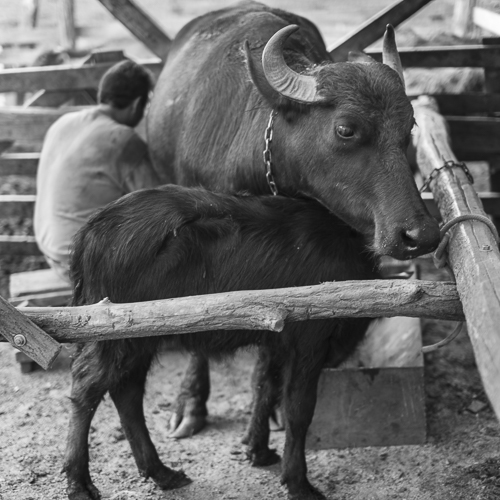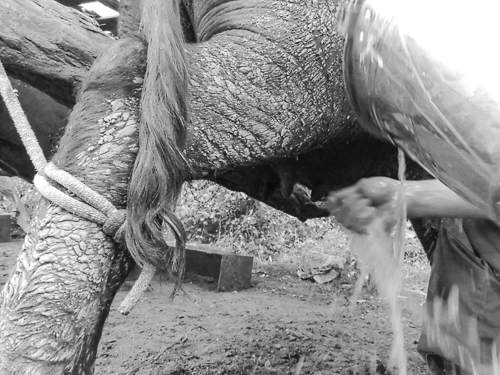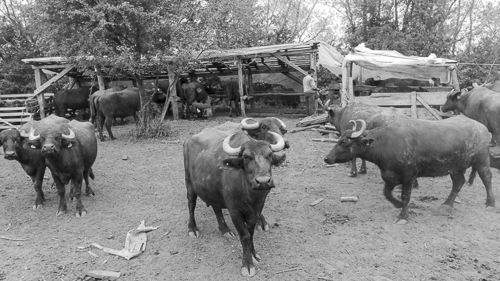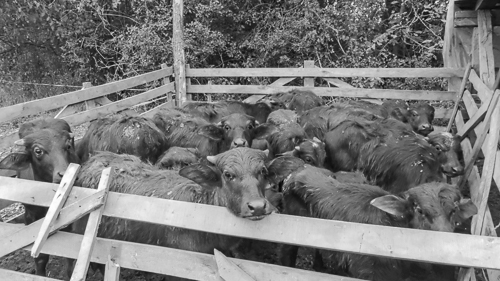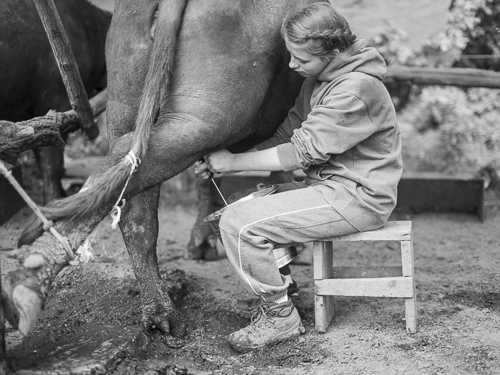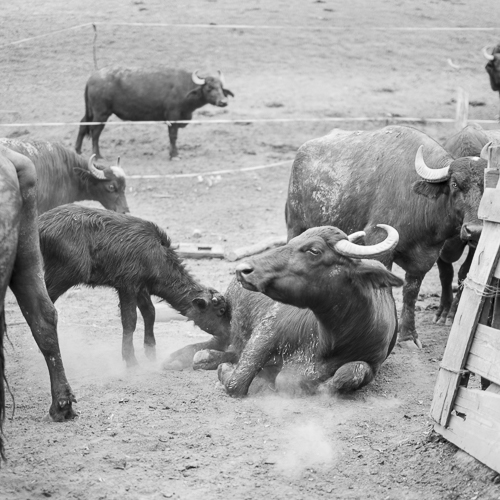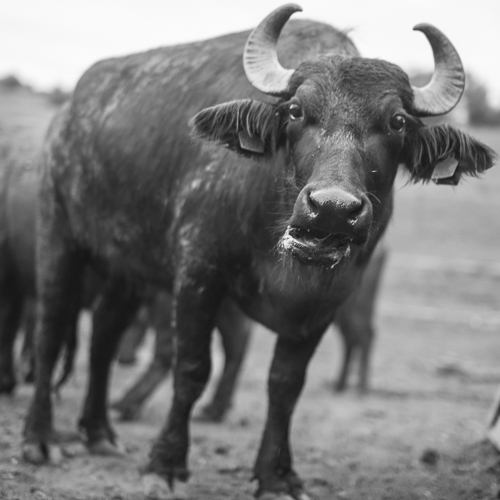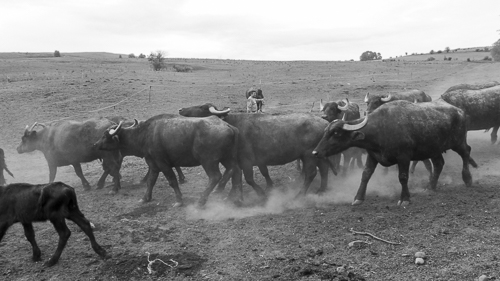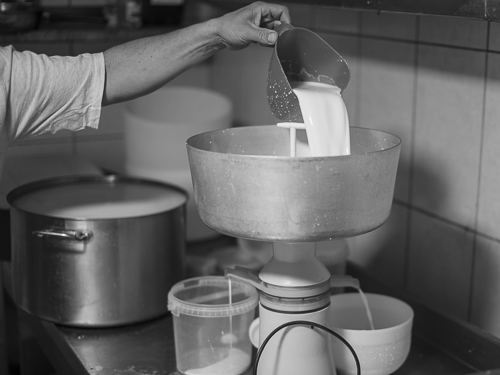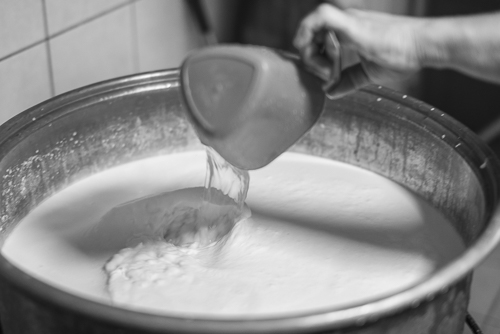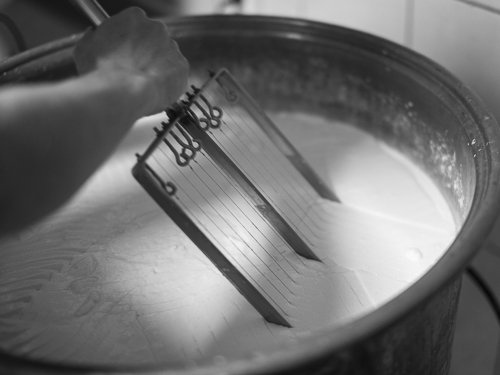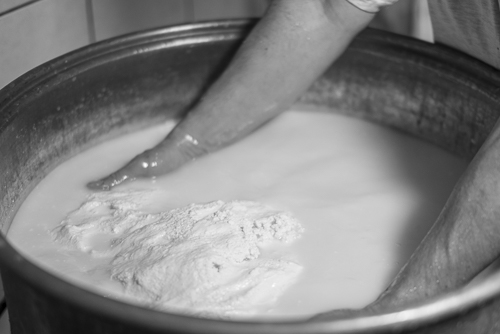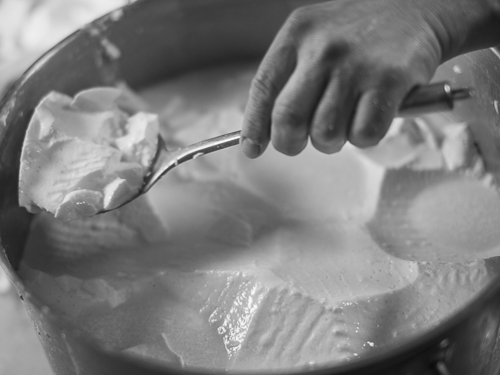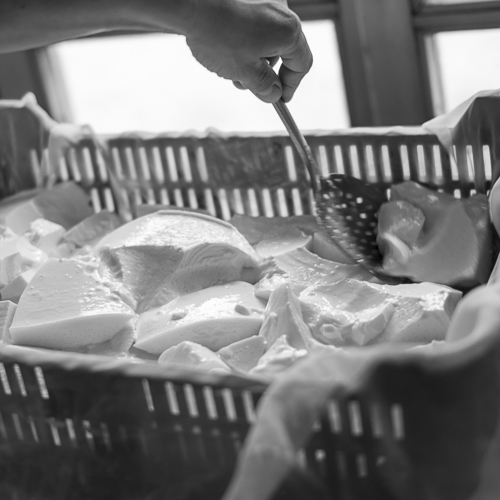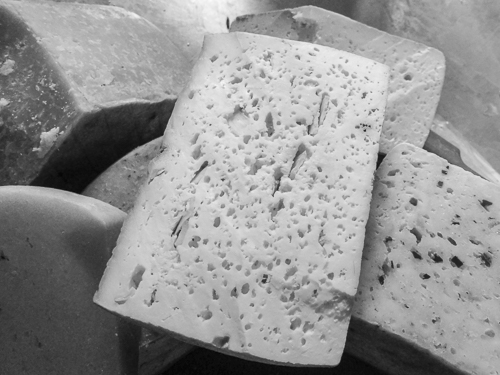We had to go early in the morning to be able to meet Mr Fülöp in the village of Székelydálya (H)/Daia (RO) at 7 in the morning. We were waiting for him when he arrived in his car, blinked the headlights and turned back to where he came from. Driving more or less offroad, we arrived at a shed where some buffaloes were waiting patiently outside a wooden shed, while others were being milked.
He was given some buffaloes by people who gave up raising them. Some of them had been roaming freely and never been milked. Before milking them, they tied the hind leg to a pole and the tail to the hind leg and let their calves stay with them to calm them down. Moreover, they were given an injection of a muscle relaxant to loosen their muscles.
Before milking, they were rinsing the udders with water, next the buffaloes were milked by hand. When they had finished milking, they carried the bucket to a container with a filter and poured the milk through the filter.
Each buffalo had to be followed to the milking space, even those that had been milked before.
The calves resided in a separate pen and they were led one by one to their mothers when being milked. Since each buffalo looked quite different from everyone else, Mr Fülöp and a worker knew which calf belonged to which buffalo.
The milking place consisted of a shed, it was located above the village and it was surrounded by rolling meadows and a few trees.
In addition to Mr Fülöp, the worker and two adolescents were milking the buffaloes, each of them sitting on wooden chairs. An audio recording of the milking and a dissatisfied buffalo can be heard here.
It seemed like the men always used force to get the buffaloes to stand where they needed in order to be milked, while the youths obtained the same without. It may have been because the young ones got the buffaloes, which had been milked before and were used to being milked, while the men were milking the buffaloes which hadn’t been milked before and were semi-wild.
There was an electrical fence surrounding the buffaloes and small groups of horses and some buffaloes, which may have been too young to produce milk, were grazing outside the fence.
A suckling calf kept suckling even when its mother lay down on the ground.
Some of the buffaloes were ruminating, moving their lower jaw sideways continuously.
When all the buffaloes had been milked, they were let out with their calves and they could go wherever they wanted, but they seemed to prefer to stay in the area.
Next, we followed Mr Fülöp back to the village where the worker got off at his place and the youths, actually his eldest children, presumably went home for breakfast. Next, he went to an abandoned building where his family had a small dairy. There, he emptied the fresh milk in a copper container and turned on a natural gas heater in order to heat the milk to about 40°C.
Having made the necessary preparations, he could present himself. He started studying theology in 1997 and he did youth work for the bishop. He had been a Presbyterian priest for 13 years. His wife is Hungarian and they have 5 kids, two of whom were milking the buffaloes. The three eldest were home-schooled, while the fourth child went to school and the fifth one was a baby. It’s a small community, but it can’t support a priest and his family. Anyway, it’s a good place for their children to grow up. 80-90% are Hungarian-speaking and there is an 800 year old church in the village. He has chosen this lifestyle because he likes it.
It was love at first sight, not necessarily requited, when he saw buffaloes for the first time and he started raising them 12 years ago. A friend from Hungary wanted to milk them and a local man had 50 buffaloes for sale. He worked as an interpreter for his friend and he was given some buffaloes at the sale. Later, he bought 10 buffaloes, which had been milked and he was given some buffaloes by people, who didn’t want them any more. They hadn’t been milked before, they had calves and he was paying the former owner 1kg of cheese per day.
Hay is best for the buffaloes to make good milk and 500 cylinders of hay are ready for the winter. The buffaloes are hardy animals and they can stay outside all year, but he will let them stay in a former communist building this winter.
Regarding cheese-making, he first took out some litres of milk and put it in a container above a separator and separated the milk into sour cream and skimmed milk. Finally, he poured the skimmed milk back into the copper container.
He told my guide that it was a cheese-making course in 2007 nearby and his wife attended the course and he learnt cheese-making from her. He also said that his wife was better at cheese-making than him, but she was attending to their baby.
There is a Hungarian association for cheese-making and its members are making trips abroad to cheese producers. Once they went to Italy in order to learn how to make their own bacteria culture. In addition, a Hungarian cheese-maker lives near his wife’s birthplace and they can ask him for advice, likewise a Swiss cheese-maker.
When the milk was heating up, he went out and brought back buffalo yogurt for use as a bacteria culture, mixed it with soured milk in a tub, stirred it and poured it back in the copper container. As described here, adding soured milk to the fresh milk leads to two beneficial characteristics:
· preventing growth of unwanted bacteria.
· contribute to maturing the cheese and developing taste.
Adding yogurt obtained from the same buffaloes as the fresh milk was necessary in order to make the milk start curdling.
After some time, when the temperature of the milk was as wanted, he added rennet to the warm milk in order for it to curdle or coagulate such that it would form a gel after about 45 minutes. Next he was heating the milk, stirring it by hand, turning off the heat, stirring, reheating, stirring, turning off heat, manually controlling the temperature until he was satisfied.
Then, he applied a metal tool, which is called a harp, to divide the gel into curds and whey. Next, he put his arms in the cheese vat and started collecting the curds in one big mass.
He collected it, put a cloth around it and lifted it up and put it in a perforated plastic container, compressed it manually and put a weight on it, making the whey flowing out of a hole into a plastic container.
During the cheese-making, he told my guide that he wanted to replace the shed with a barn next year, the land has water sources for the animals, even in dry times, he wanted to buy milking machines next year and expand the dairy, no pasteurisation was necessary because the milk was turned into cheese within 2 hours, he felt at home in this village, there were always lots of work to do, he could sell more than 40 kg of cheese at a local market and some of the calves would be sold later.
When we arrived at the dairy, there was one kettle full of soured milk and another one with sour cream. Now, he brought the last one to his workbench and used a sieve to scoop up pieces of sour cream.
Having already covered a plastic crate with a porous cloth, he left the pieces of sour cream in the crate. He repeated this procedure until the kettle was empty. In this way, he made cream cheese.
Finally, he let us taste various cheeses with or without herbs and various stages of maturity. It was a delicious way of ending a pleasant and interesting visit.
For reference, I have been to farms with buffaloes and they have been described here and here. The Romanian buffalo is described here and here.
